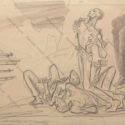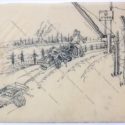Towards the end of 1944 many people already felt that the end of the war was approaching. In the Battle of the Bulge, western allies troops thwarted the attempts of the German Army to control the Western Front, and a few weeks later the Red Army launched a massive winter offensive on the Eastern Front. Although everything was moving towards the ultimate collapse of the Third Reich, no-one could predict precisely when the end would come. As written by the British historian Ian Kershaw in his monograph titled The End: Germany 1944-1945 (Brno, Jota 2013): “After the failure of the Ardennes Offensive there was no more place for real optimism and faith in the good end of the war for Germany. Except for lunatics, stubbornly hoping for wonder-weapons or disintegration of the anti-Hitler coalition, the Germans understood well that the days of the regime would soon be numbered. However, nobody around Hitler, who at all times insisted on continuing the fight, was able or willing to do anything about the situation. Thus, the heavily breathing regime went on.”
The measures and events which took place in the Terezín ghetto during the first months of 1945 may seem rather contradictory to anyone unfamiliar with different ghetto’s roles (reception/transit, decimation, alibi/propaganda). On the one hand, the Nazi management supported buck-passing events: recall the February departure of 1,200 prisoners to Switzerland, April transport of Danish inmates organized by the Swedish Red Cross or the April second delegation of the International Committee of the Red Cross, again preceded by beautifying activities. On the other hand, there were considered plans for the disposal of prisoners in a gas chamber, which was not completed though, and in the adjusted area of part of the fortification ditches surrounding the Terezin Main Fortress called the “Duck Pond” (see Newsletter 1/2010). Transports to the ghetto were not ceased either. They were bringing Jews from mixed marriages, who had been protected from deportations until then, together with people classified as Jews of mixed race under the Nuremberg racial laws. The situation in the ghetto began to deteriorate generally more with the arrivals of so-called evacuation transports from the concentration camps in liquidation. They nearly doubled the number of inmates and raised new demands on accommodation, food and particularly medical sector in the ghetto. Prisoners arriving by evacuation transports were in fact of very poor health, often infected with serious diseases, such as typhus fever, which threatened to escalate into an epidemic. Eventually that exactly happened. The epidemic was first combated by Jewish doctors imprisoned in the ghetto, later also by members of the Czech Help Action (CPA) and the Red Army medics. This catastrophic situation was not reversed even by the fact that on 2nd May 1945 the ghetto and the Small Fortress went under the official protection of the International Committee of the Red Cross represented by its delegate Mr. Paul Dunant.
- Fröhlich, M.: Památníček – Theresienstadt 1945, PT 12518
- Štěch, K.: Poprava 2. května 1945, PT 7501
- Lederer, B.: Odvoz mrtvých, PT 9686
Similarly tragic was the situation in the Gestapo police prison in the Small Fortress during the last months of the war. Just like in the ghetto, the Nazi prison headquarters speculated here about the possible ways of mass liquidation of prisoners, however, for technical reasons, those plans were eventually dropped. The health condition of prisoners was rapidly deteriorating. Reports on this matter reached in various ways the medical circles of nearby Roudnice nad Labem as well as Prague. There, particularly doctors working in the resistance groups became interested in the prisoners’ health situation. After the establishment of the Czech National Council as the supreme body of the Czech home resistance, medical assistance to prisoners of the Small Fortress was formed. Its organization was entrusted to MUDr. Karel Raška, epidemiologist of the National Public Health Institute in Prague. On 2nd May 1945, on the day when the Gestapo headquarters in Prague ordered to shoot 52 prisoners in the Small Fortress (see Newsletter 2/2010) who, in their point of view, should no way live to see the liberation, Raška along with other colleagues arrived at the gate in order to convince the prison commanders about the need for outside medical interventions. According to available evidence, the prison seemed to be infected with typhus fever. After two days of negotiations he finally succeeded, and from 4th May a medical team of the Czech Help Action from Prague began to work in the police prison in the Terezin Small Fortress, soon joined by a group of medics from Roudnice nad Labem. In this way they started a several-week fight against the epidemic of typhus fever, which claimed many more lives.

Formal sitting of doctors and medical personnel of the Czech Help Action in Terezín, June 1945, FAPT 7627_3_3
When the last members of the SS and supervisory personnel left the Terezin Small Fortress and ghetto on 5th May 1945, the suffering of many prisoners was still not over. On 8th May 1945, Soviet troops heading for Prague arrived in Terezín, but they were not the first military units passing through after the Nazi administration of the ghetto and Gestapo prison had departed. These were divisions of the German Armed Forces, which were retreating before the Red Army. For prisoners, with merely a few hours to spare before the arrival of their liberators, they meant just another danger to life and limb. For example, one passing SS convoy shelled a hospital in Vrchlabí barracks, and another building near the gendarmerie barracks in this town was hit with a shell as well. Red Army soldiers, along with their doctors, returned to Terezín on 10th May.

“Riding hall” in flames during the fight against epidemic typhus fever, branch of CC Flossenbürg in Litoměřice, May 1945, FAPT 105_2
Towards the end of the war evacuation transports were also coming to a branch of the Flossenbürg concentration camp nearby Litomeřice. However, this camp was, unlike Terezín, eventually evacuated itself. As a result of the arrival of many new prisoners, similarly to the ghetto, the living conditions worsened and mortality significantly increased. Not only for that reason a crematorium in the operation of nearby brickworks was set up: one of the buildings was rebuilt just for that purpose. In addition to many dead prisoners of the Litoměřice concentration camp the corpses of people shot down on 2nd May 1945 during the last execution in the Small Fortress were cremated here as well. In late April 1945, Jewish prisoners were moved to Terezin and others were gradually removed to the station in Lovosice, where they waited several days in terrible conditions for the dispatch of railway transport. At the turn of May, another transport was under preparation, but it did not leave in the end. Subsequently, a most unusual thing in the entire existence of Nazi concentration camps happened. On 6th May 1945, prisoners were issued a certificate of release and were walked from Litomerice over the bridge over the Elbe to the town of Terezín, leaving only approx. 1,200 ill prisoners behind in the camp, who were also nursed by the Czech Help Action staff and Red Army medics after the liberation.
Šp







